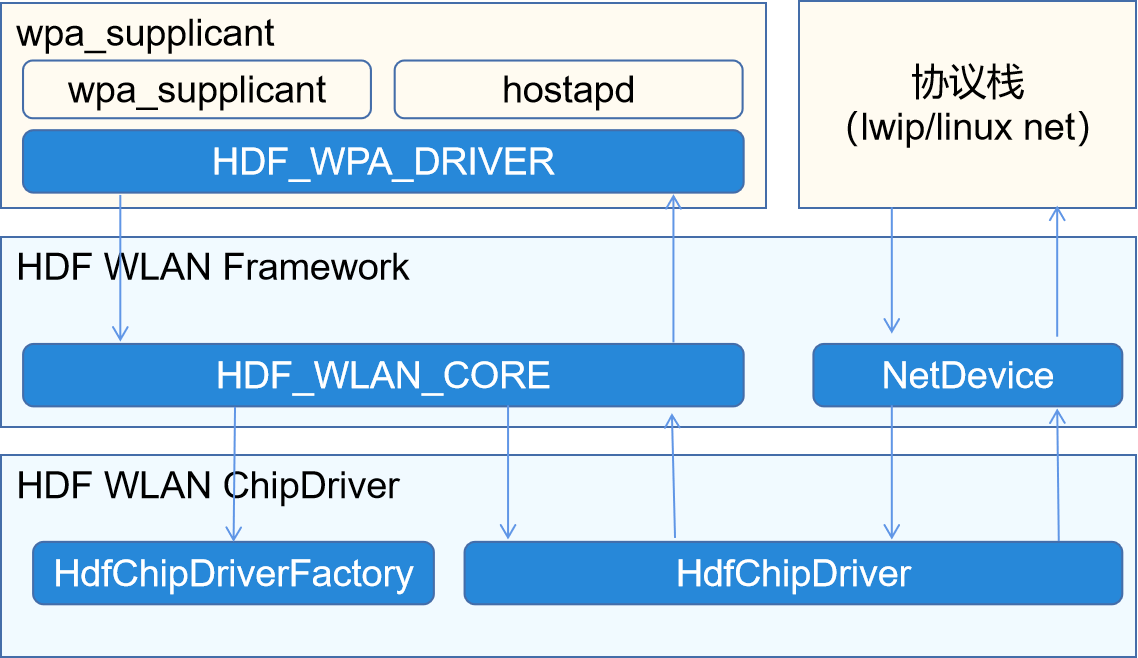器件驱动移植
本章节讲解如何移植各类器件驱动。
LCD驱动移植
移植LCD驱动的主要工作是编写一个驱动,在驱动中生成模型的实例,并完成注册。
这些LCD的驱动被放置在源码目录//drivers/framework/model/display/driver/panel中。
-
创建Panel驱动 创建HDF驱动,在驱动初始化中调用RegisterPanel接口注册模型实例。如:
int32_t LCDxxEntryInit(struct HdfDeviceObject *object) { struct PanelData *panel = CreateYourPanel(); // 注册模型实例 if (RegisterPanel(panel) != HDF_SUCCESS) { HDF_LOGE("%s: RegisterPanel failed", __func__); return HDF_FAILURE; } return HDF_SUCCESS; } struct HdfDriverEntry g_xxxxDevEntry = { .moduleVersion = 1, .moduleName = "LCD_XXXX", .Init = LCDxxEntryInit, }; HDF_INIT(g_xxxxDevEntry); -
配置加载panel驱动 产品的所有设备信息被定义在源码文件//vendor/vendor_name/product_name/config/device_info/device_info.hcs中。修改该文件,在display的host中,名为device_lcd的device中增加配置。
 注意:
moduleName 要与panel驱动中的moduleName相同。
注意:
moduleName 要与panel驱动中的moduleName相同。root { ... display :: host { device_lcd :: device { deviceN :: deviceNode { policy = 0; priority = 100; preload = 2; moduleName = "LCD_XXXX"; } } } }
TP驱动移植
本节描述如何移植触摸屏驱动。触摸屏的器件驱动被放置在源码目录//drivers/framework/model/input/driver/touchscreen中。 移植触摸屏驱动主要工作是向系统注册ChipDevice模型实例。
详细的驱动开发指导,请参考 TOUCHSCREEN开发指导。
-
创建触摸屏器件驱动 在上述touchscreen目录中创建名为touch_ic_name.c的文件。编写如下内容
#include "hdf_touch.h" static int32_t HdfXXXXChipInit(struct HdfDeviceObject *device) { ChipDevice *tpImpl = CreateXXXXTpImpl(); if(RegisterChipDevice(tpImpl) != HDF_SUCCESS) { // 注册ChipDevice模型 ReleaseXXXXTpImpl(tpImpl); return HDF_FAILURE; } return HDF_SUCCESS; } struct HdfDriverEntry g_touchXXXXChipEntry = { .moduleVersion = 1, .moduleName = "HDF_TOUCH_XXXX", // 注意这里的moduleName要与后续的配置完全一致 .Init = HdfXXXXChipInit, }; HDF_INIT(g_touchXXXXChipEntry);其中ChipDevice中要实现如下方法:
| 方法 | 实现说明 |
|---|---|
| int32_t (*Init)(ChipDevice *device) | 实现器件初始化 |
| int32_t (*Detect)(ChipDevice *device) | 实现器件探测 |
| int32_t (*Suspend)(ChipDevice *device) | 实现器件休眠 |
| int32_t (*Resume)(ChipDevice *device) | 实现器件唤醒 |
| int32_t (*DataHandle)(ChipDevice *device) | 需要实现从器件读取数据,将触摸点数据填写入device->driver->frameData中 |
| int32_t (*UpdateFirmware)(ChipDevice *device) | 实现固件升级 |
-
配置产品,加载器件驱动 产品的所有设备信息被定义在源码文件//vendor/vendor_name/product_name/config/device_info/device_info.hcs中。修改该文件,在名为input的host中,名为device_touch_chip的device中增加配置。
 说明:
moduleName 要与触摸屏驱动中的moduleName相同。
说明:
moduleName 要与触摸屏驱动中的moduleName相同。deviceN :: deviceNode { policy = 0; priority = 130; preload = 0; permission = 0660; moduleName = "HDF_TOUCH_XXXX"; deviceMatchAttr = "touch_XXXX_configs"; }
WLAN驱动移植
WLAN驱动分为两部分,一部分负责管理WLAN设备,另一个部分负责处理WLAN流量。
图1 OpenHarmony WLAN结构示意图

如图1,左半部分负责管理WLAN设备,右半部分负责WLAN流量。HDF WLAN分别为这两部分做了抽象,驱动的移植过程可以看做分别实现这两部分所需接口。这些接口有:
| 接口 | 定义头文件 | 接口说明 |
|---|---|---|
| HdfChipDriverFactory | drivers\framework\include\wifi\hdf_wlan_chipdriver_manager.h | ChipDriver的Factory,用于支持一个芯片多个WLAN端口 |
| HdfChipDriver | drivers\framework\include\wifi\wifi_module.h | 每个WLAN端口对应一个HdfChipDriver,用来管理一个特定端口 |
| NetDeviceInterFace | drivers\framework\include\wifi\net_device.h | 与协议栈之间的接口,如发送数据、设置网络接口状态等 |
说明: 详细的接口开发指导,请参考WLAN开发。
具体的移植步骤如下:
-
创建HDF WLAN 芯片驱动 在目录/device/vendor_name/peripheral/wifi/chip_name/ 创建文件 hdf_wlan_chip_name.c。内容模板如下:
static int32_t HdfWlanHisiChipDriverInit(struct HdfDeviceObject *device) { static struct HdfChipDriverFactory factory = CreateChipDriverFactory(); // 需要移植者实现的方法 struct HdfChipDriverManager *driverMgr = HdfWlanGetChipDriverMgr(); if (driverMgr->RegChipDriver(&factory) != HDF_SUCCESS) { // 注册驱动工厂 HDF_LOGE("%s fail: driverMgr is NULL!", __func__); return HDF_FAILURE; } return HDF_SUCCESS; } struct HdfDriverEntry g_hdfXXXChipEntry = { .moduleVersion = 1, .Init = HdfWlanXXXChipDriverInit, .Release = HdfWlanXXXChipRelease, .moduleName = "HDF_WIFI_CHIP_XXX" // 注意:这个名字要与配置一致 }; HDF_INIT(g_hdfXXXChipEntry);在上述代码的CreateChipDriverFactory方法中,需要创建一个HdfChipDriverFactory类型的对象。该对象提供如下方法
| 接口 | 说明 |
|---|---|
| const char *driverName | 当前driverName |
| int32_t (*InitChip)(struct HdfWlanDevice *device) | 初始化芯片 |
| int32_t (*DeinitChip)(struct HdfWlanDevice *device) | 去初始化芯片 |
| void (*ReleaseFactory)(struct HdfChipDriverFactory *factory) | 释放HdfChipDriverFactory对象 |
| struct HdfChipDriver *(*Build)(struct HdfWlanDevice *device, uint8_t ifIndex) | 创建一个HdfChipDriver;输入参数中,device是设备信息,ifIndex是当前创建的接口在这个芯片中的序号 |
| void (*Release)(struct HdfChipDriver *chipDriver) | 释放chipDriver |
| uint8_t (*GetMaxIFCount)(struct HdfChipDriverFactory *factory) | 获取当前芯片支持的最大接口数 |
其中Build方法负责创建一个管理指定网络接口的对象HdfChipDriver 。该对象需要提供方法:
| 接口 | 说明 |
|---|---|
| int32_t (*init)(struct HdfChipDriver *chipDriver, NetDevice *netDev) | 初始化当前网络接口,这里需要向netDev提供接口NetDeviceInterFace |
| int32_t (*deinit)(struct HdfChipDriver *chipDriver, NetDevice *netDev) | 去初始化当前网络接口 |
| struct HdfMac80211BaseOps *ops | WLAN基础能力接口集 |
| struct HdfMac80211STAOps *staOps | 支持STA模式所需的接口集 |
| struct HdfMac80211APOps *apOps | 支持AP模式所需要的接口集 |
-
编写配置文件描述驱动支持的芯片 在产品配置目录下创建芯片的配置文件,保存至源码路径//vendor/vendor_name/product_name/config/wifi/wlan_chip_chip_name.hcs
该文件模板如下:
root { wlan_config { chip_name :& chipList { chip_name :: chipInst { match_attr = "hdf_wlan_chips_chip_name"; /* 这是配置匹配属性,用于提供驱动的配置根 */ driverName = "driverName"; /* 需要与HdfChipDriverFactory中的driverName相同*/ sdio { vendorId = 0xXXXX; /* your vendor id */ deviceId = [0xXXXX]; /*your supported devices */ } } } } } 说明:
路径和文件中的vendor_name、product_name、chip_name请替换成实际名称
说明:
路径和文件中的vendor_name、product_name、chip_name请替换成实际名称vendorId 和 deviceId需要根据实际芯片的识别码进行填写。
-
编写配置文件,加载驱动 产品的所有设备信息被定义在源码文件//vendor/vendor_name/product_name/config/device_info/device_info.hcs中。修改该文件,在名为network的host中,名为device_wlan_chips的device中增加配置。模板如下:
deviceN :: deviceNode { policy = 0; preload = 2; moduleName = "HDF_WLAN_CHIPS"; deviceMatchAttr = "hdf_wlan_chips_chip_name"; serviceName = "driverName"; } 说明:
moduleName 要与HDF WLAN 芯片驱动中的moduleName相同。
说明:
moduleName 要与HDF WLAN 芯片驱动中的moduleName相同。 -
修改Kconfig文件,让移植的WLAN模组出现再内核配置中 在device/vendor_name/drivers/Kconfig中增加配置菜单,模板如下
config DRIVERS_HDF_WIFI_chip_name bool "Enable chip_name Host driver" default n depends on DRIVERS_HDF_WLAN help Answer Y to enable chip_name Host driver. 说明:
请替换模板中的chip_name为实际的芯片名称
说明:
请替换模板中的chip_name为实际的芯片名称 -
修改构建脚本,让驱动参与内核构建 在源码文件//device/vendor_name/drivers/lite.mk末尾追加如下内容
ifeq ($(LOSCFG_DRIVERS_HDF_WIFI_chip_name), y) # 构建完成要链接一个叫hdf_wlan_chipdriver_chip_name的对象,建议按这个命名,防止冲突 LITEOS_BASELIB += -lhdf_wlan_chipdriver_chip_name # 增加构建目录gpio LIB_SUBDIRS += ../peripheral/wifi/chip_name endif 说明:
请替换模板中的chip_name为实际的芯片名称
说明:
请替换模板中的chip_name为实际的芯片名称